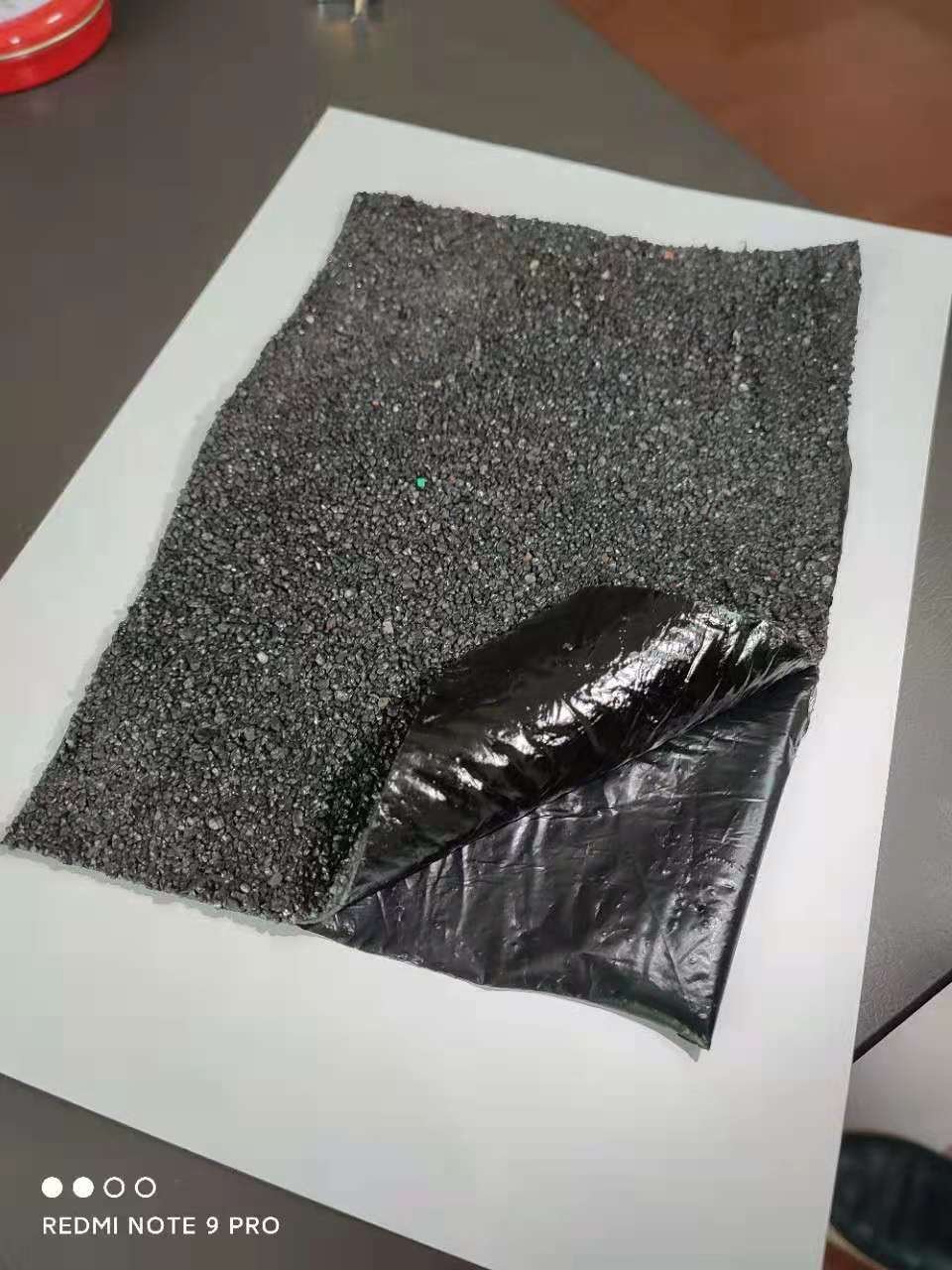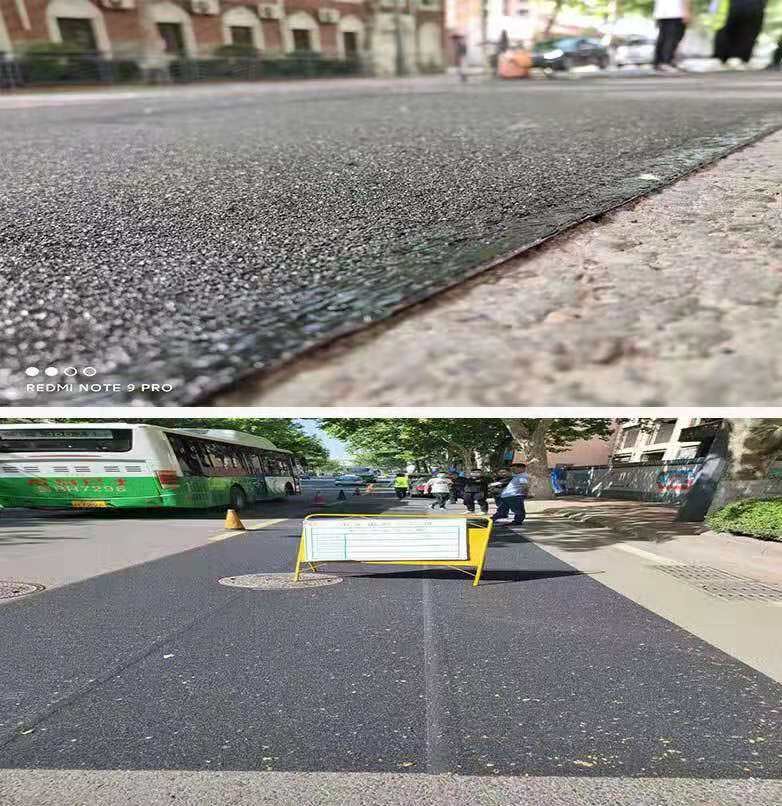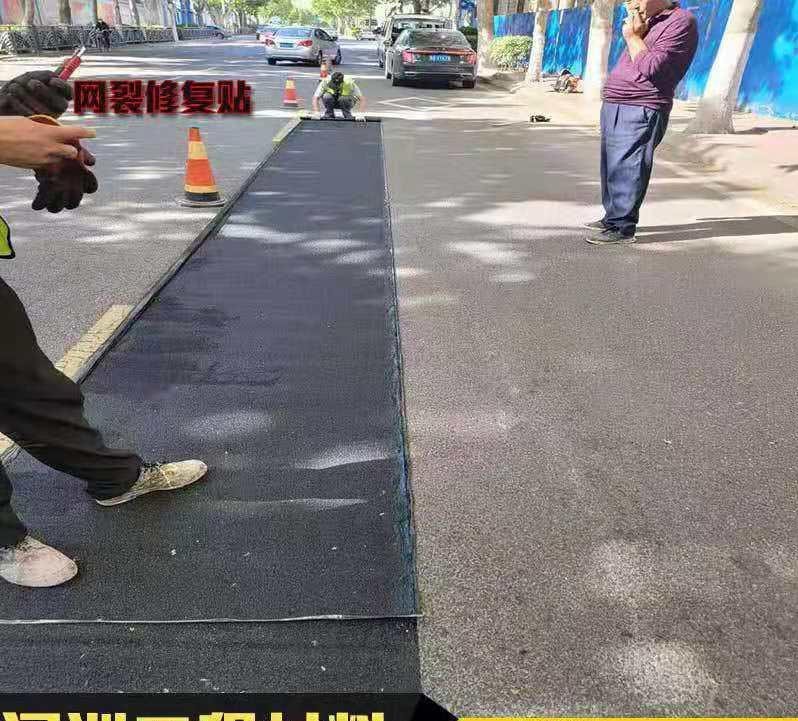The self-adhesive crack patch is packaged in rolls and is a fast road repair material for solving road cracks and cracks. The main material is high polymer modified asphalt, and the stone particles are made of basalt crushed stones of a certain grade. The self-adhesive crack patch has a three-layer structure: easy-to-remove protective isolation film + high polymer modified asphalt + graded crushed stone. The self-adhesive crack patch has a simple construction process, does not require heating, and is environmentally friendly. There is no emission of dust, smoke and other harmful substances during construction. It can be rolled and pasted, spliced or cut according to the road conditions, without material waste, and achieves green energy-saving and environmentally friendly construction.
The research and development of self-adhesive cracked mesh stickers solves the problems of low construction efficiency, large traffic impact, large equipment and high cost investment in the early treatment of local road diseases. It is a factory-produced pavement wear layer. It is directly peeled off and pasted on the cracked parts by manual or mechanical means. After rolling, the purpose of quickly repairing local road diseases can be achieved. Different types of self-adhesive cracked mesh stickers have the advantages of water sealing, crack resistance, anti-slip, low noise, simple construction, no need for heating, no equipment investment, and rapid opening of traffic.
- Technical advantages of cracked mesh stickers
1) Rapid opening of traffic: self-adhesive cracked mesh stickers can quickly repair road cracks. Traffic can be opened after construction without maintenance or waiting.
2) Direct pasting without heating: self-adhesive cracked mesh stickers are self-adhesive, and the main material is high polymer modified asphalt, which has the characteristics of strong bonding. During the construction process, no fire baking is required. After paving and rolling, it can be firmly bonded to the road surface.
3) Quick construction: The self-adhesive crack patch is a high-bonding type with a wide temperature range. The construction can be completed in three steps: cleaning, peeling off the film, pasting, and rolling.
4) Sealing and waterproofing: The self-adhesive crack patch can effectively seal the cracks in the road surface to prevent rainwater from seeping into the cracks and causing further damage to the road surface.
5) Low noise and anti-skid: After the self-adhesive crack patch repairs the cracks in the road surface, the colloid is embedded in the cracks in the road surface after a period of vehicle rolling, which can effectively reduce driving noise. Due to the presence of graded gravel, it also ensures that the vehicle will not slip when driving on it.
6) Low carbon and energy saving: No heating is required during the construction of the self-adhesive crack patch, saving fuel consumption.
7) Cost saving: The self-adhesive crack patch can be constructed by two people and does not require large equipment, saving a lot of construction costs.
8) High temperature non-flow and low temperature crack resistance: The high polymer modified asphalt used in the self-adhesive mesh crack patch has added rubber, SBS and other additives, improved softening point and cone penetration, so that the self-adhesive mesh crack patch has better high and low temperature performance than ordinary asphalt materials, and can achieve non-stick at 90℃, and special customization at minus 40℃ without brittle cracking.
- Preparation of mesh crack patch construction tools
1) Backpack hair dryer or broom, used to blow away dust and debris on the road surface.
2) Scissors or wallpaper knife, used for cutting mesh crack patches.
3) Iron roller or small roller, used to compact the mesh crack patch after paving.
- Mesh crack patch construction process
Self-adhesive mesh crack patch is self-adhesive, no need for fire baking, no construction equipment, and only 3 simple steps are needed to repair road cracks and mesh cracks.
1) Road cleaning:
Use a portable hair dryer or broom to blow away dust and loose soil in the mesh crack area.
2) Crack filling (if necessary):
For individual wide cracks or tiny potholes, you can use self-adhesive seam tape twisted into strips or balls to fill them and then apply the crack patch;
When the crack width of the crack is greater than 8 mm, you need to fill the crack with grouting material. The filling material can be flush with the road surface and cannot exceed 3 mm from the road surface;
For small potholes, you can use a wire brush to clean the loose soil and loose materials in the potholes to expose a stable bonding surface, and then use 10-grain self-adhesive cold patch material to fill and compact. After the potholes and wide cracks are treated, you can proceed to the next step.
3) Peel off the film and paste:
Put the rolled self-adhesive cracked mesh sticker at one end of the cracked mesh area, peel off a section of the protective film and stick the self-adhesive cracked mesh sticker on the road surface, then one person pulls the film, and the other person rolls the rolled self-adhesive cracked mesh sticker along the cracked mesh area until the self-adhesive cracked mesh sticker covers the entire cracked mesh area. During the pasting process, the self-adhesive cracked mesh sticker should extend more than 10cm on both sides of the cracked mesh area.
4) After pasting, roll it 1-2 times with an iron roller or a small roller to ensure compaction.
5) Open traffic. After opening traffic, the repair effect will be better after being rolled by vehicles.
- Storage of cracked mesh stickers
Please store the self-adhesive cracked mesh stickers in a dry and normal temperature place, avoid humid and high temperature environments, and the stacking height should not exceed 4 layers to avoid deformation of the cracked mesh stickers and accumulation of stone particles due to overweight stacking.
- Precautions for using the crack patch
1) In order to better integrate the self-adhesive crack patch with the road surface, it is recommended to construct it in late spring and early autumn, and avoid the rainy season. If it is necessary to construct it in late autumn, ensure compaction.
2) When the road surface temperature is lower than 10℃, it is recommended to use a blowtorch to bake the crack area and then paste it while it is hot to ensure the pasting effect. It is recommended to stop construction when the night temperature is lower than 4℃.
3) Before pasting, ensure that the road surface is dry and there is no moisture in the cracks. It is recommended to suspend construction within 24 hours before and after rainfall or road sprinkling.
4) For road diseases such as unsolid roadbed, obvious abnormal movement of vehicles passing by; severe rutting, rutting depth greater than 2cm; poor drainage, long-term water accumulation on the road surface, etc., it is recommended to use self-adhesive cold patch material for filling and repair after direct milling.
5) For intersections and uphill (downhill) locations on heavily loaded roads, and locations where large vehicles (cargo weight of more than 5 tons) often turn around on the spot, it is generally not recommended to use cracked mesh stickers for repair.
6) After pasting, it is necessary to check whether the self-adhesive cracked mesh stickers have been compacted to prevent hollowing and failure to stick to the road surface. After this phenomenon occurs, if there are few vehicles on the road and it happens to be sprinkled with water, rain, or humid weather for a short period of time, the self-adhesive cracked mesh stickers will begin to fall off from the hollow or uncompacted areas.
7) When the cracked area of the mesh is wide, it can be overlapped and pasted, with an overlap of 2-3 cm. The overlap and edges should be rolled several times to ensure a strong bond.



